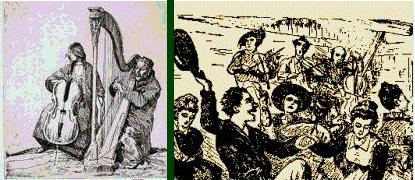In response to mycatmarti, here’s what I know about chop – that percussive
chk sound that some cellists put into their playing at times. The effect is somewhat similar to the slap that old-time/bluegrass bassists sometimes do. Notable practitioners of the technique include Rushad Eggleston, Natalie Haas, and Dr. Renata Bratt.
In the DVD “Chops and Grooves,” Eggleston joins fiddlers Darol Anger and Casey Dreissen in demonstrating the technique. Dr. Bratt describes the technique some in her Book/CDs “The Fiddling Cellist,” and gives more examples in “Celtic Grooves for Two Cellos” which includes some of the patterns Natalie Haas plays.
Chops are not played alone, but together with normal notes as part of a rhythmic pattern called a “groove”. I will attempt to explain how the technique is performed, but direct observation and instruction with someone already adept at the technique is far better. To begin, I’ll describe four types of chop:
The hard chop is executed by bringing the bow straight down hard, just an inch or so from the frog and close to the bridge, striking the strings (usually the C and G strings) from above at an angle and skidding to a stop. The skid into the string across the windings produces a
chk sound. This is the most common chop.
A soft chop can executed in much the same way but by bringing the bow with less force, and further from the bridge.
Another chop, the up-bow chop, is a yet softer sound. It can be executed by scraping the bow back up off the string, usually immediately after a hard chop. The result of a hard chop followed by an up-bow chop is a
chk-a sound.
Yet another type of chop is the ghost chop. The ghost chop makes no sound, but that’s ok. It’s just a light bounce off the strings as a place-keeper, to physically maintain a constantly flowing rhythm in the hand. As Rushad puts it, "
Feel the boogie."
I think the most important thing to point out about the chop is that a little goes a long way. Too much gets annoying real fast.
Here an audio example with chop from a CD by Dr. Bratt, with Rushad and guitarist Jim Lewis: a pleasant rendition of that good ol’ standard,
Cripple Creek. Notice how well they integrate chop into the normal notes.
Chop is relatively new, the exact technique for executing chop has not been codified, so there’s considerable variation in the way the motion is executed. Rushad uses a lot of finger motion, extending his fingers down quite straight in order to strike the strings. Natalie, on the other hand, uses her her whole arm to bring the bow down, with virtually no finger action that I can see.
From observations at a New Directions Cello Festival workshop lead by Natalie with assistance from Dr. Bratt, the problem most beginners have with executing chop is that the bow bounces off the string instead of sinking into it. If the bow bounces off the string, there’s no
chk sound.
Why the bounce? I've found that the bow bounces when the the wrist is too tense. If the wrist is tight, like a stretched rubber band, well sure, the bow/hand/arm combination just bounces right off. To sink into the string on a chop requires a wrist that gives; one that acts like a shock absorber rather than a spring.
Those who ride horses Western-style will understand exactly what I mean. Especially at the trot, a beginner's butt bounces unmercifully against the saddle: SMACK– SMACK – SMACK… Ouch!!! Why? Because the rider’s calves are tight. Beginner’s legs act like rubber bands, propelling frightened, hapless novices up into the air with each horse stride. And what goes up, must come down. Hard. The competent rider bounces very little because his calves stretch but stay relaxed, acting like slack, compliant shock absorbers, ever yielding to the horse’s motion. So too, with the chop. The wrist must yield; in just the right way.
I find I cannot chop well with finger extension alone, as Rushad seems to do. I need a whole arm approach. Something like the motion of slapping one's thigh with the heel of the hand.
Watch Natalie in this YouTube video (The chop pattern starts about one third into the video):
Fraser and Haas. I’ll think you’ll come to the same conclusion I do. Note that, unlike Rushad, she strikes the string far from the bridge. Her petite, light bow arm and hand come down so easily and effectively her C string usually clacks against the fingerboard. Powerful --- but no bounce.
If there's interest, I'll post some groove patterns in music notation.




